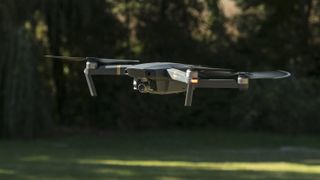Airborne drone charging could be about to solve your battery woes
It takes more than faith, trust, and pixie dust

Scientists from Imperial College London have recently made a breakthrough that enables drones to be wirelessly powered while they're still in the air.
The technology utilizes 'inductive coupling', a concept initially proven by Nikola Tesla, which involves electronically tuning two copper coils into one another, enabling a wireless exchange of power at a certain frequency.
Although scientists have been experimenting with it for many years, the researchers believe this is the first time it’s been used to power an airborne device.
To prove that the method would work, the researchers bought an ordinary quadcopter drone, altered its electronics and removed its battery. They encircled the drone’s casing with a copper foil ring to act as a receiving antenna, while on the ground a transmitter device made out of a circuit board was connected to a power source, creating a magnetic field.
Flying high
The drone’s altered electronics were then tuned to the frequency of the magnetic field, which meant that when the drone flew into this field its receiving antenna was able to pick up the electronic current and use it to stay in flight.
Right now the technology is still in its early stages, and as a result the drone has to stay fairly close to the source of the magnetic field to get any power from it. Despite this, the team think they’re only one year away from a commercially viable project which could be used as the foundation for advancements in commercial drone technology.
Drones are being used more than ever for commercial purposes, from the oil and gas industries using them to cut costs and improve efficiency to online retailers like Amazon looking to set up drone delivery services.
Get daily insight, inspiration and deals in your inbox
Get the hottest deals available in your inbox plus news, reviews, opinion, analysis and more from the TechRadar team.
One of the main limitations of using drones is that the length of time they’re able to stay in the air is constrained by their batteries and charging requirements; this is a problem that wireless power transfer could efficiently solve.
Dr Samer Aldhaher, a researcher from the Department of Electrical and Electronic Engineering at Imperial College London, said "there are a number of scenarios where wirelessly transferring power could improve drone technology."
He foresees the use of ground support vehicles being used as mobile charging stations "where drones could hover and recharge, never having to leave the air".
To take the project further and explore possible applications, the team is now planning to collaborate with industrial partners. To see the experiment in action for yourself, just check out the video below…
Emma Boyle is TechRadar’s ex-Gaming Editor, and is now a content developer and freelance journalist. She has written for magazines and websites including T3, Stuff and The Independent. Emma currently works as a Content Developer in Edinburgh.
Most Popular



